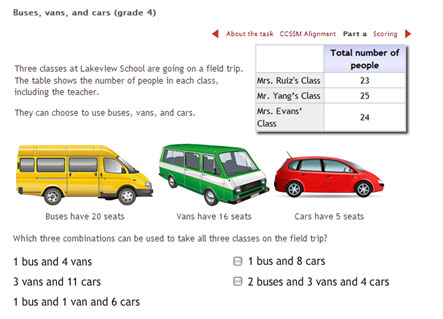 MONTGOMERY COUNTY PUBLIC SCHOOLS
MONTGOMERY COUNTY PUBLIC SCHOOLS
 MONTGOMERY COUNTY PUBLIC SCHOOLS
MONTGOMERY COUNTY PUBLIC SCHOOLS
The improvements to the math curriculum are in response to several factors and will result in MCPS students having a stronger, more comprehensive understanding of mathematical concepts. Reasons include:
The Common Core State Standards (CCSS) demand a higher level of thinking in math for all students.
Computation and procedures were sufficient to reach success in previous curriculum and assessments. The CCSS requires students to show greater depth by demonstrating their Understanding, Computing, Applying, Reasoning, and Engagement (UCARE) in mathematics. As a result, the math content at each grade level is more difficult than previous curriculum.
Curriculum 2.0 expands access to higher-level math courses.
MCPS designed C2.0 so that all students can reach Algebra 1 by Grade 8. The curriculum was intentionally designed to build a strong foundation in number sense in the earliest grades so that all students will be well prepared for the challenging courses in middle school that lead to Algebra 1 completion in Grade 8. Students who meet this goal will have the option to enroll in an AP mathematics course in high school. Even students who do not reach Algebra 1 in Grade 8 will still be able to complete Algebra 2 in high school, meeting one of the University System of Maryland entrance requirements.
Curriculum 2.0 asks more of students and provides a higher level of challenge for all students:
Curriculum 2.0 mathematics includes enrichment and acceleration opportunities.
MCPS Curriculum 2.0 exceeds the requirements of the Common Core State Standards. Based on feedback from national experts, MCPS created acceleration and enrichment opportunities not included in the Common Core State Standards for students who need it. MCPS also went beyond the Common Core State Standards to design options for students to reach Geometry in Grade 8.
Curriculum 2.0 mathematics includes options for above-grade-level acceleration.
Students who demonstrate readiness through an identification process at the end of Grade 3 will have the option to enroll in the Grades 4/5 compacted Math course. It is important to note that due to the increase in the rigor of the grade level curriculum, far fewer students than in previous years will need to skip a grade level in elementary mathematics to be challenged.
Where can I find additional information about the compacted Grades 4/5 course?
Information for parents on Curriculum 2.0 mathematics can be found online at https://www.montgomeryschoolsmd.org/curriculum/math/ and includes informational brochures, parent videos, and PowerPoint presentations for use at meetings.
Compare the left test question below from the Grade 5 Maryland School Assessment (MSA) to the right test item from the Grade 4 Partnership for Assessment of Readiness for College and Career (PARCC). PARCC will replace the MSA. Note that:

The art teacher has 824 paint brushes. He wants to put 8 brushes in a box. How many boxes can he fill?